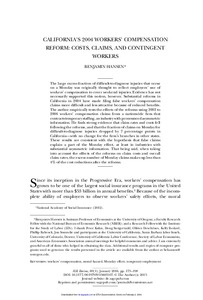California's 2004 workers' compensation reform. Costs, claims, and contingent workers

2016
69
1
January
173-198
social security reform ; temporary employment ; workers' compensation
Social protection - Occupational accident /disease benefits
http://dx.doi.org/10.1177/0019793915605507
English
Bibliogr.
"The large excess fraction of difficult-to-diagnose injuries that occur on a Monday was originally thought to reflect employees' use of workers' compensation to cover weekend injuries. Evidence has not necessarily supported this notion, however. Substantial reforms in California in 2004 have made filing false workers' compensation claims more difficult and less attractive because of reduced benefits. The author empirically tests the effects of the reforms using 2002 to 2006 workers' compensation claims from a nationwide firm that contracts temporary staffing, an industry with pronounced asymmetric information. He finds strong evidence that claim rates and costs fell following the reforms, and that the fraction of claims on Monday for difficult-to-diagnose injuries dropped by 7 percentage points in California—with no change for the firm's branches in other states. These results are consistent with the hypothesis that false claims explain a part of the Monday effect, at least in industries with substantial asymmetric information. That being said, when taking into account the effects of the reforms on claim costs and overall claim rates, the excess number of Monday claims makes up less than 4% of the cost reductions after the reforms."
Digital
The ETUI is co-funded by the European Union. Views and opinions expressed are however those of the author(s) only and do not necessarily reflect those of the European Union or the ETUI.